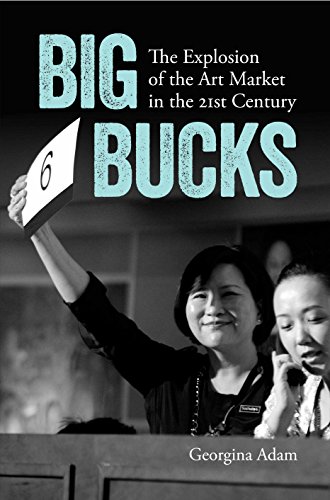 |
| Picture: Amazon |
Georgina Adam Big Bucks: The explosion of the art market in the 21st century Lund Humphries 2014 £19.99
Georgina Adam is one of the smartest art market commentators, and this book is a lively view of today's craziness. She's especially penetrating in her analysis of the market's corruption - both the corruption of the market and corruption by the market. For example, she tells us that members of Tate's collection committee each donate at least £10,000 a year - or, to put it less politely, buy their way on. Though she doesn't draw it out in this particular case, that gives opportunity to promote purchase of artists that the committee members collect, boosting their value. And it skews the Tate's collection towards art cherished by rich collectors who are not necessarily the sharpest connoisseurs (though some of course are the sharpest connoisseurs; my point is simply that connoisseurship is not proven by a donation of ten grand).
Adam quotes an anonymous American museum director:
"The problem of collectors sitting on museum boards and trying to use their position to validate their own holdings is ubiquitous, and is being exacerbated by the new class of trustees, who today are investor-collectors ... They will try to use their position to either influence the purchases of the institution, in line with their own collection, or have their own works included in museum exhibitions. You cannot imagine how cajoled and caressed I have sometimes been to take a painting into a show!" (p. 172)
Actually I can imagine. And this is the tragedy of the contemporary art market - not that collectors over-pay for fashionable mediocrity, but that the ghastly bad taste of the contemporary market pollutes the public sphere by influencing museums.This book gives insight into how the contemporary art world works.
I thought Adam was weaker when discussing the art market in its wider sense because she doesn't situate the changes to the art business in the context of changes to other businesses. She speaks of increased professionalisation, like the use of PR firms, and increased globalisation and scale. But none of this is unique to art dealing; the economy has become more global, and many business sectors have become more commercialised. There are lots of comparisons between art dealing today and art dealing in the past, but too little comparison of the art trade and other trades.
On the specifics of the market, I also had disagreements with Adam's analysis. She claims that auctioneers can offer guarantees because they are so much better capitalised than dealers (p. 35), but in fact auctioneers are agency businesses that are quite thinly capitalised. They typically finance guarantees by seeking wealthy third parties as underwriters, as Adam herself notes elsewhere. And comments on collectors today being more likely to jump in at the top end of the market, or being more focused on the investment angle, are speculative. It's hard to know if the story here is about the changing nature of the art collector or the changing perception of the art collector.
I'm more confident that Adam is wrong about the accelerating overlap between the commercial and non-commercial art worlds (p. 91). Connoisseurs like Berenson were utterly implicated in commerce, and many experts sold certificates of authenticity, advised dealers and collectors or traded art themselves. There has been a period when museums moved more consciously to distance themselves from the trade, and I agree that has been breaking down. But it's a more nuanced story than the rupture implied here. And I spotted a number of other minor errors along the way; Andrea Mantegna's Adoration of the Magi was only sold in 1985, not in the 1970s (p. 32), for example, and The Birdtrap (more commonly Winter Landscape with Skaters and a Birdtrap) is actually a painting by Pieter Bruegel the Elder, in Brussels, although Pieter Brueghel the Younger did indeed paint many versions of his father's picture (p. 74).
In the conclusion Adam speculates about whether the art market is 'too big to fail', but this is to misunderstand the concept of too big to fail. It normally applies to businesses or sectors whose failure would cause negative spill-overs to the rest of the economy - banks, because their failure would leave businesses and individuals with no access to funds and no means of money transmission, or major manufacturing businesses like car companies whose failure would cause knock-on effects for a massive supply chain. No one argues that to be the case with the art market. A decline in value of art would affect the richest people, who can most easily afford it.
Adam's long experience reporting on the art market has given her insight into how the market operates and how its actors relate, but some of her wider claims about recent changes needed more grounding in history and economics.
No comments:
Post a Comment